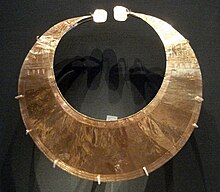Lunula (archeology)
The lunula (plural: lunulae , from Latin luna , the moon; lunula , the small moon or 'the crescent moon ') is used in archeology to describe crescent-shaped objects from the late Neolithic to the early Bronze Age, mostly made of thin gold sheet. In southern France ( Dolmen de la Verdoline ) and on the Iberian Peninsula , specimens made of slate (Necropolis of Baútas, Amadora) and bronze are known. The gorget is a special form of the lunula .
Ireland
Ireland ( Blessington ) is considered the place of manufacture of the golden specimens, but they were also found in Great Britain ( Llanllyfni , Wales ), Scandinavia , Poland and Germany ( Butzbach and Schulenburg in the Hanover region ). The gold lunula , which was found in the Pattensen district of Schulenburg, is the only gold lunula from Lower Saxony , while three lunulae made of copper are known from another location with the copper treasure from Osnabrück from 2016. Mostly the Irish lunulae are interpreted as necklaces (Ross in County Westmeath ). However, since they were never found in the context of a grave, their use or way of carrying them is unknown in Central and Northern Europe.
Portugal
Portuguese lunulae are usually made of slate . These were probably worn with the tips down, which is indicated by the position of the two eyelets , which are usually two . Such specimens were found in the Cascais caves and at Trigache 2. The five-hole lunula by Cabeço da Arruda 2 does not give an exact indication of how it is worn, as does the multi-hole fragment by Pedra dos Mouros. However, the arrangement of the holes suggests different possibilities. There are also unperforated finds from Praia das Maçãs and Trigache 3 as well as the golden lunula from Cabeceiras de Basto and Lunulae, which are recognizable engraved on statue menhirs such as those from Portela de Mogos .
See also
swell
- ^ Hans Hahne: Das Goldgeschmeide von Schulenburg In: JB Provinzial-Museum Hannover 1911/12, page 86ff.
- ↑ Early gold. Prehistoric and early historical gold finds from Lower Saxony ( find histories and cultural-historical impressions). Pages 31–34. Lower Saxony State Museum Hanover. Isensee Verlag Oldenburg 2003. ISBN 3-89995-066-6
literature
- George Eogan: The accomplished art. Gold and gold-working in Britain and Ireland during the Bronze Age (c.2300–650 BC). Oxbow Books, Oxford 1994, ISBN 0-946897-72-7 ( Oxbow monograph 42).
- Georg Leisner , Vera Leisner : The megalithic tombs of the Iberian Peninsula. The West. De Gruyter, Berlin 1956 ( Madrid Research 1, 1, ISSN 0418-9736 ).


